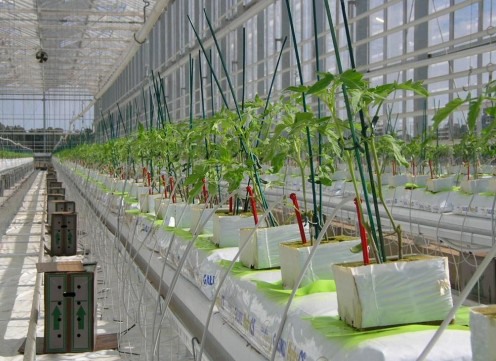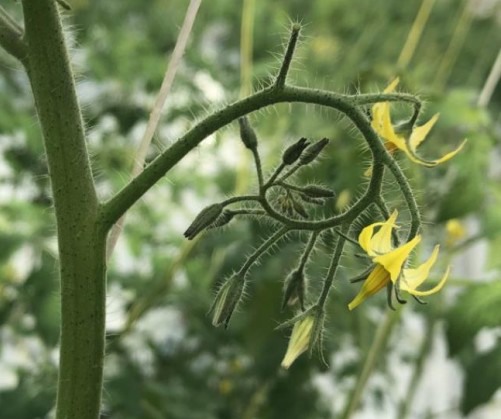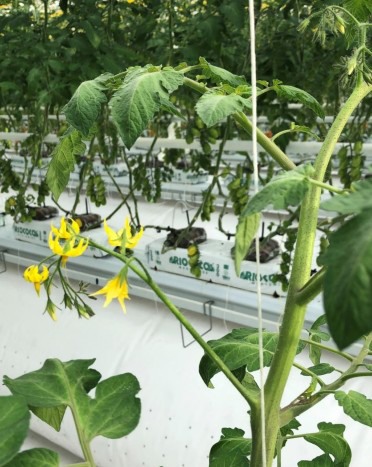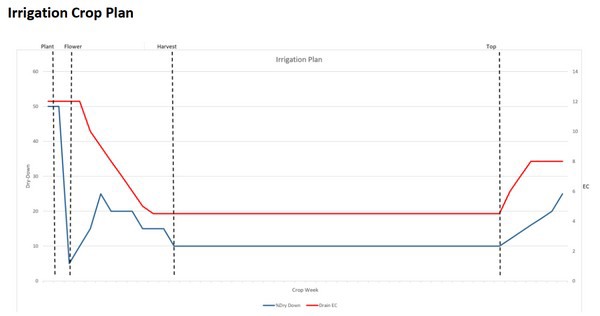"Follow the rules of thumb and the plant performs as required" was the headline in the previous post in a series of three about irrigation. In this last part Godfrey Dol is looking into what makes the rules.
A tomato crop has 5 distinct periods that require a different approach to irrigation. Godfrey discusses the strategies for each period, for a crop of tomatoes grown in a high light climate. In low light climates the strategies may be quite different.
Different strategies - Propagation
In high light climates, young plants tend to grow vegetative. To counteract this, the block can be dried down to 40-50% of the saturation weight as soon as the roots emerge from the bottom. Usually, a 10 x 10 x 7.5 cm block weighs about 500 grams when it is saturated. It means that the block can be dried down to 250-300 grams. The irrigation must be given in the morning so that the blocks are not too wet at night.
When the plants suck water out of the blocks, air replaces it, providing the roots with necessary oxygen. The EC in the block can run up to 12 applying this practice, which makes the plant more generative and encourages the roots to fill the block. It also prevents the long, stringy roots that form when too much water is applied, and form puddles on the surface. The roots grow into these puddles, forming long roots that break off when the plants are planted in the glasshouse.
Different strategies - Planting to Flower
Most growers in warm climates do not have access to nurseries that can deliver a plant at the flowering stage. If the plants are small when they arrive from the propagator, the grower needs to complete the propagation cycle. When there are conditions of high light and low humidity, it causes the plant to make large leaves to cool itself. There are no fruits on the plant that function as a sink for assimilates.
If allowed to grow without intervention, this plant grows very vegetative. The grower must give generative impulses that force the plant to flower and fruit. One well-known aspect of fruiting plant species is that threatening environmental conditions causes the plant to act reproductively. Most growers make use of this fact by not allowing the roots of the plant to grow into the growing media.
An example of this is shown in Figure 1 below. The green sheet prevents the roots from going from the block into the slab with more volume.
 Fig 1; Controlling the Plant. Godfrey advises to use coloured sheets to prevent the roots to go in the slab. Transparent sheets are difficult to see and when they are removed, they can easily be overlooked if they have not been taken away.
Fig 1; Controlling the Plant. Godfrey advises to use coloured sheets to prevent the roots to go in the slab. Transparent sheets are difficult to see and when they are removed, they can easily be overlooked if they have not been taken away.
By doing this, the volume of the growing media is restricted. Even a little plant can suck the moisture out of the block, which gives the grower control over moisture and salt content of the root zone. Drying down the weight of the block to 50% of its saturation weight is a generative impulse through which the plant starts producing hormones that steer it towards reproduction.
The irrigation must be carefully controlled. Weighing the blocks multiple times per day allows the grower to dry the blocks down to 50% of their saturation weight. The plants should not go into the night with a wet growing medium. If the plants need irrigation, irrigate in the morning when the temperature is still cold. Check those areas of the glasshouse that are warmer or receive more light (wall or gable rows), are not drying out (and wilting) sooner.
It is preferred to have the irrigation hoses under the gutter so that the sun does not have a chance to heat the irrigation water.
The EC in the drip should be 4.0. When the blocks are irrigated, the water system can be stopped when the first drain is visible. If it is evident that there is too much variance in EC between blocks, more drain needs to be realized. The EC in the block can rise to EC = 10-16. It creates a generative impulse.
The trend is to use less nitrogen in the fertilizer formula at this time to stop encouraging the plant to become vegetative. It seems low nitrogen also helps in increasing Brix of the fruit.
Different strategies - Flower to Harvest
Once the flowers on the first truss are open, the plastic sheet is removed, allowing the roots to grow into the larger volume of root space. The longer this action can be postponed, the better it is for the generativity of the plant.
However, not allowing the plants to anchor themselves into the slab makes them unstable, and they might fall over, even when tied up to the string. The falling over of the plant may become the determining factor when plants should be allowed to root into the slab.
By the time of planting, the EC in the block is 10-16. The slab must be filled with EC=4 irrigation water. This difference in EC forces the roots to go into the slab very quickly. A nice truss such as shown in figure 2 is a sign that the plants are generative. Notice the extreme curl in this cherry truss.
If the irrigation is given too late in the afternoon, or the growing media is kept too wet, the trusses become more elongated and stick up, as shown in figure 3.
 Figure 2; Nice curl in the truss because of generative steering with irrigation
Figure 2; Nice curl in the truss because of generative steering with irrigation
After planting, the plants have access to the almost unlimited water supply in the bag. It is a dangerous situation as the availability of so much water creates a vegetative impulse. To reduce this effect, apply the following rule of thumb; restrict the irrigation after planting and reduce the moisture content in the slab by 1-2% per day. It means that after 10 days, the water uptake of the plants creates a dry down of 15%. The decrease in water content must be realized with zero drain. After two to three weeks, the drain starts, and the EC in the drain from the slab is at 6-10. From this time on, reduce the drain EC by 0.5-1.0 EC unit per week. The EC should be at EC=4.5 by the time harvesting commences. Bring the drip EC down gradually to EC = 3.0.
 Three weeks after allowing the roots into the slab, the dry down is 20%, and it should remain above 20% until one to two weeks before harvesting or earlier if the plants show a more generative appearance. Achieve this by stopping early with the irrigation and giving more water during the day between start and stop times to control the EC. Late irrigations have an extraordinarily strong vegetative impulse, causing trusses to stick up straight (see figure 3) instead of the nice curl shown in figure 2.
Three weeks after allowing the roots into the slab, the dry down is 20%, and it should remain above 20% until one to two weeks before harvesting or earlier if the plants show a more generative appearance. Achieve this by stopping early with the irrigation and giving more water during the day between start and stop times to control the EC. Late irrigations have an extraordinarily strong vegetative impulse, causing trusses to stick up straight (see figure 3) instead of the nice curl shown in figure 2.
If it seems the dry-down is too much overnight, night irrigations are a better choice. But in most cases, it is better to stop early. You can always give extra irrigations, but you cannot take one away after its given. The grower has an essential input in irrigation management. The weather is different every day, and the stop time of the irrigation varies as a result.
Figure 3 above; Truss sticking up do to late irrigation.
Different strategies - Harvest and Beyond
If everything went right, we should have a well-balanced plant, loaded with fruit, ready for harvest. The highest fruit load on the plant takes place approximately one month after harvesting begins. At maximum load, the plants required nurturing. The grower must make it as easy as possible for the plant to grow. The majority of the assimilates that the plant makes are used for fruit production. Nurturing the plants helps stimulate vegetative growth and guarantee a future harvest. Now is the time to switch from generative to vegetative actions. The focus switches from the plant, making fruits, to making leaves and maintaining sufficient head width.
The dry-down of the slab must quickly decrease to 10% or less. It means irrigating later into the day. By now, the EC in the drain should be 4.5, while the drip should be at EC = 3.0. With less light, the plants require less irrigation. The following rule of thumb can be applied;
The last irrigation should come at 200 joules before sunset. If the dry down is too high, night irrigation can be given between 9 and 11 pm. It is important to remember that the guidelines above emerge from a desire to maintain the correct EC. In other words, keeping the right EC is the prime directive. The drain percentage is a means to achieve this. If the EC is too high, more frequent irrigations in the middle of the day bring the EC back down. Using a lower EC in the drip water to achieve this, is not recommended. Some companies want to achieve a higher Brix by maintaining a higher EC. A lower drain percentage is required to maintain a higher EC.
Different strategies - Topping
About 6 weeks before the end of the crop, the growing point is removed. The remaining seven to eight trusses ripen one by one over the next 6 weeks until the plant is empty. Removing the growing point results in the plant needing less assimilates for growth, making leaves and roots. The majority of assimilates that the plant creates are used for fruit growth. Due to the decreasing fruit load, the plant has a smaller buffer to direct water to the fruits when root pressure is high. Therefore root pressure must be reduced. We do this by increasing the EC and dry-down. The dry down can be increased slowly from 10% at topping to 25% at last harvest. The EC can be increased to 8. Due to the reduced fruit load, there are more assimilates available for the last couple of trusses. Even with a high EC, the fruit size up properly.
Irrigation Crop Plan

Click here for the enlargement of Figure 4, Irrigation Crop Plan
Irrigation is a very important tool in the arsenal of a grower. The EC and dry-down can be used to push a plant in a vegetative or generative direction. The influence is particularly strong at the start of the crop when the plant has mostly leaves, and no fruit to attract assimilates. Using a high EC and a large dry-down, we can steer the plant generatively. From the target drain EC, it emerges what amount of water we should give. From the dry-down, the stop time of the last irrigation can be determined. These are the two driving forces that determine the irrigation strategy.
If we lay out the discussion above into an irrigation plan describing the 5 stages of a crop, the graph in figure 4 emerges. These are guidelines that reflect the needs of the crop. Of course, the requirements can change. A plant may become too vegetative after harvesting, and this may mean that the grower wants to increase the dry-down. It is a guideline that reminds the grower of the plan that he had in mind. Deviating from the plan requires a reason, which forces internal reflection on the grower to substantiate his decision. Especially for growers who are isolated, away from other growers, this can be a helpful process.
Looking at the main variables every day focuses the attention, and small deviations are caught before they become a problem. After all, we know we never get it completely right, but if we keep trying, we get it close to perfect.
Summary - algorithm vs. 38 years experience
This part 3 in the series has shown that irrigation strategies require a much more complicated approach to something that seems so simple. I could not have imagined when I took on the responsibility of watering my sisters plants that, one day, I would write a 5,000 blog about it.
However, these blogs also shows that there are only four main parameters that we need to control to create a sound irrigation strategy. The key to understanding irrigation is that the weather can change every day and as a result, the irrigation strategy needs to be looked at frequently. It is the discipline of doing this daily that is important. Collecting the right information, making sure that the information is correct, determining the strength of the plant and anticipating the weather are important.
But by looking at the strategy every day, patterns emerge and the management becomes a lot simpler than it may seem in this part of the series.
The strategies described above were the strategies used in the 2020 Autonomous Glasshouse Challenge by the winning team AuTomatoes. Applying these rules resulted in the lowest water and fertilizer use of all teams, including the grower reference team.
During the challenge, the team developed an algorithm predicting when the last irrigation should occur to achieve the desired drydown. Godfrey learned that an algorithm, tied to weather prediction, is much better at it than I am with 38 years experience. There is no doubt that this type of technology will soon find its way into commercial applications, simplifying irrigation strategies for growers.
For more information:
Glasshouse Consultancy
www.glasshouse-consultancy.com
Godfrey Dol
LinkedIn
godfrey@glasshouse-consultancy.com
+81 80 700 94 006
